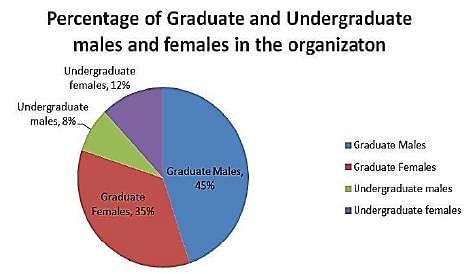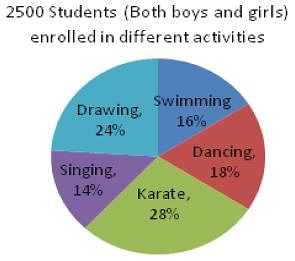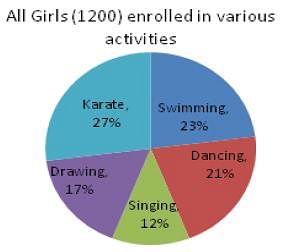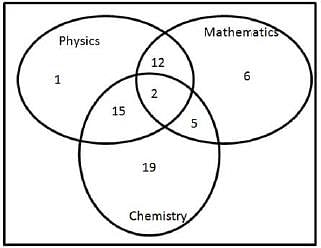APSC CCE Prelims (Paper 2) Mock Test - 1 - APSC CCE (Assam) MCQ
30 Questions MCQ Test APSC CCE Mock Test Series 2024 - APSC CCE Prelims (Paper 2) Mock Test - 1
Given below is an inequality, which of the following condition is TRUE?
If P ≤ Q ≥ R; E ≥ Q; L < Q = D
Biodiversity is the living fabric of our planet. It underpins human well-being in the present and in the future, and its rapid decline threatens nature and people alike. According to reports released in 2018 by the Intergovernmental Science-Policy Platform on Biodiversity and Ecosystem Services (IPBES), the main global drivers of biodiversity loss are climate change, invasive species, over-exploitation of natural resources, pollution and urbanization .Biodiversity loss implies the reduction and disappearance of species and genetic diversity and the degradation of ecosystems. It jeopardizes nature‘s vital contributions to humanity, endangering economies, livelihoods, food security, cultural diversity and quality of life, and constitutes a major threat to global peace and security. Biodiversity loss also disproportionally affects the most vulnerable exacerbating inequality .To halt or reverse this decline it is vital to transform people‘s roles, actions and relationships with biodiversity. This transformation has already begun with the commitment of the international community to the 17 Sustainable Development Goals (SDGs) of Agenda 2030. This global and holistic framework highlights the complex interconnections and interdependencies between society, biodiversity and sustainable development. It recognizes that human behaviour, values and choices shape people‘s interactions with biodiversity, all of which have a direct impact on our collective future on the planet. Awareness and appreciation of the diverse values of biodiversity need to be further amplified and mainstreamed within this global framework in order to transform human behaviour in favour of biodiversity conservation and its sustainable use. Many solutions exist for stopping and reversing the decline in biodiversity. UNESCO‘s diverse networks, programmes and partners have observed positive and inspiring seeds of change around the world. UNESCO also accompanies Member States and their people in their efforts to halt biodiversity loss by understanding, appreciating, safeguarding and using biodiversity sustainably. This publication highlights some of UNESCO‘s biodiversity-related actions and solutions, based on the Organization‘s unique mandate and its diverse normative instruments, networks, programmes and partners. These actions have reduced biodiversity loss and improved the lives of many people around the planet. For each thematic challenge, the publication highlights current actions and solutions that have been successfully implemented, as well as suggestions for improvement and innovation.
Q. Which of the following statements is incorrect?
Read the information given below carefully and answer the following question.
Much has been said and written about what foreign direct investment (FDI) in retail can do. Depending on which side of the ideological divide is speaking, the assertions are either that it is a magic wand to fix many big problems or that it is a destroyer of honest livelihoods, with little benefits of its own. What is common to both sides is that they are mostly low on fact, high on opinion and generate enormous amounts of confusion. Which is why, I think it is necessary to sift through all of the nose and look truth in the eye. The facts, as I see it, tell us that it has become a symbolic issue, far beyond what reality demands it ought to be; and that there is no need for either great celebration or for deep despair over the idea that FDI in retail is now a reality. My analysis tells a fairly straightforward story.
The government has hugely exaggerated the quantum and immediacy of benefits it put on the table to sell the policy-that common man will benefit enormously, employment generation will be huge, the country’s supply chain will be transformed and large numbers of small producers and farmers will gain. As things stand, even if modern retail were to take off on all cylinders, these arguments would still not hold water for the next 10 years.
For one, there is the fact that aside from very old markets like America and Europe, in most newly developed markets, modern trade accounts for only 20-25 percent of all retail. India is already at 8 percent-which is significant – but the impact hasn’t been as dramatic as one would have assumed.
Then there is the fact that the economics of the Indian market is such that it makes little sense for global retailers to focus on all consumers. I am convinced they will focus their energies on the top 33 percent of urban Indian households (a mere 10 percent of all Indian households); investing in the others isn’t quite what they know how to do profitably yet.
As for small manufactures, I don’t see that huge numbers of them will benefit. Retailers across the world like to work with a small group of select vendors because it makes for better profitability. So yes, a small number will benefit significantly. And yes, employment will be generated. But it won’t be anywhere close to the numbers now being touted.
Then there is the argument that encouraging modern retail to invest will provide the much-needed booster shot for the country’s dismal supply chain infrastructure. Here again, let’s face it. Retailers aren’t in the business of building national infrastructure. About the only infrastructure they’d be interested in is their last mile.
The only argument that holds true is that kiranas or the small, traditional shopkeepers who are now an Indian staple, will not die. But that is a tribute to the small shopkeeper rather than prescience on the part of the government.
Q. With which of the following about the benefits of FDI in retail would the author agree?
1. The common man may not benefit greatly.
2. Employment generation may not be that huge.
3. Farmers and small producers shall be benefited greatly.
The government has hugely exaggerated the quantum and immediacy of benefits it put on the table to sell the policy-that common man will benefit enormously, employment generation will be huge, the country’s supply chain will be transformed and large numbers of small producers and farmers will gain. As things stand, even if modern retail were to take off on all cylinders, these arguments would still not hold water for the next 10 years.
For one, there is the fact that aside from very old markets like America and Europe, in most newly developed markets, modern trade accounts for only 20-25 percent of all retail. India is already at 8 percent-which is significant – but the impact hasn’t been as dramatic as one would have assumed.
Then there is the fact that the economics of the Indian market is such that it makes little sense for global retailers to focus on all consumers. I am convinced they will focus their energies on the top 33 percent of urban Indian households (a mere 10 percent of all Indian households); investing in the others isn’t quite what they know how to do profitably yet.
As for small manufactures, I don’t see that huge numbers of them will benefit. Retailers across the world like to work with a small group of select vendors because it makes for better profitability. So yes, a small number will benefit significantly. And yes, employment will be generated. But it won’t be anywhere close to the numbers now being touted.
Then there is the argument that encouraging modern retail to invest will provide the much-needed booster shot for the country’s dismal supply chain infrastructure. Here again, let’s face it. Retailers aren’t in the business of building national infrastructure. About the only infrastructure they’d be interested in is their last mile.
The only argument that holds true is that kiranas or the small, traditional shopkeepers who are now an Indian staple, will not die. But that is a tribute to the small shopkeeper rather than prescience on the part of the government.
1. The common man may not benefit greatly.
2. Employment generation may not be that huge.
3. Farmers and small producers shall be benefited greatly.
Read the information given below carefully and answer the following question.
Domestic workers often face very low wages, excessively long hours, have no guaranteed weekly day of rest and at times are vulnerable to physical, mental and sexual abuse or restrictions on freedom of movement. Exploitation of domestic workers can partly be attributed to gaps in national labour and employment legislation, and often reflects discrimination along the lines of sex, race and caste.
Q. Which among the following is the most logical corollary to the above passage?
Study the following information and answer the question given after that.
There are eight family members, namely P, Q, R, S, T, U, V and W. There are three married couples in the family. P is married to V. V is the father of R. R is the sister of U. T is the niece of U. Q is the father of T. S is the brother-in-law of P. U is the husband of W.
Q. How many male members are there in the family?
Read the information given below carefully and answer the following question.
Seven boys P, X, Z, N, G, L and R live in three different buildings – Ashiana, Top-view, and Ridge. Each of them is flying kites of different colours, i.e., red, green, blue, white, black, yellow and pink not necessarily in that order. Not more than three or less than two stay in any of the buildings. L is flying a pink kite and lives in the same building as only R, i.e., Ashiana. Z is flying a black kite and does not live in Ridge building. N does not live in the same building as P or G and is flying a yellow-coloured kite. X lives in Ridge building with only one more person and is flying a green kite. None in the Top view building flies a white kite. G does not fly a blue kite.
Q. Who is flying the blue kite?
Read the information given below carefully and answer the following question.
Financial inclusion plays a crucial role in inclusive development and sustainable prosperity as is being increasingly recognised and acknowledged globally. Large segment of population need to be part of formal payment system and financial markets. Financial inclusion would also broaden and deepen financial savings and lead to higher economic development.
Previous initiatives: While financial sector policies in India have long been driven by the objective of increasing penetration and outreach, the goal of inclusion has eluded us. About 41 per cent of adult population remain unbanked and the number of loan account covers only 14 percent of adult population. The previous initiatives included (i) the expansion of network of cooperative banks to provide credit to agriculture and saving facilities in rural areas, (ii) nationalism of bank in 1969 and expansion of branches and (iii) creation of an elaborate framework of priority sector lending with mandated targets as part of a strategy to meet the savings and credit needs of large section of the Indian population who had no access to institutional finance. Given the sheer enormity of the challenge, however the outcomes of these efforts have so far been mixed.
Recent initiatives/out of the box approaches: Recent initiative include (i) “no frill” account for retail purpose; (ii) simplified KYC (Know Your Customer) (iii) Credit counselling centre facilities; (iv) use of NGOs and formation of SHGs; (v) Kisan credit cards service and (vi) extension of smart cards. The finance Minister in his Budget Speech of 2007-08 also laid down provision for funding of financial inclusion goals. The Rangarajan Committee also spelt out priorities for meeting financial inclusion objectives. Two of the more important approaches in the recent times included the use of technology such as smart cards and mobile telephone banking. The potential for their spread can be vast especially in combination with banking correspondence approach launched recently.
New entry and competition: In addition, new competition and entry also play crucial roles, as is evident from the global experience. Two particular initiatives have included the role of Micro Financial Institutions (MFIs) and Non-Bank Finance Companies (NBFCs). MFI activities have surged in recent years, but has come under scrutiny and regulation. Services expanded at a fast rate, providing access on better terms than the alternatives of traditional money lenders. However, better regulation is also needed. On NBFCs, gold pawn establishment have also provided alternate access and are fast expanding in urban and semi-urban settings. As far as caps on interest rates are concerned, as in case of other products, ‘subsidies’ in the form of low interest are often an inhibitor of access to services because of rationing and misuse.
Financial Literacy: Any policy initiative seeking to afford greater access to financial services to financial services to a large segment of the population must necessarily address bridging the existing knowledge gap in financial education and literacy. Over the last decade or so, researcher all over the world, especially in the developed countries, have, therefore, started to study and explore whether individuals are wellequipped to make financial decisions. Financial education and literacy assumes urgency in any given scenario.
Q. Which of the following would be closest to the meaning of term financial inclusion?
The following pie chart represents the percentage of graduate and under graduate males and females in an organization:

Q. The difference in the central angles corresponding to the undergraduate males and undergraduate females is:
Directions: In each question, a statement is followed by two assumptions I and II. You have to consider the statement and the following assumptions and decide which of the assumption(s) is/are implicit in the statement.
Q. Statement: The queen had a stepdaughter who ruined her legacy
Assumptions:
I. The queen was/is married
II. The queen ruled wisely
Mark the answer as:
Read the information given below carefully and answer the following question.
Technological progress continues to accelerate and at some point, the technology of “mind uploading” becomes possible. Some human individuals upload and make many copies of themselves. Meanwhile, there is gradual progress in neuroscience and artificial intelligence, and eventually it becomes possible to isolate individual cognitive modules and connect them up to modules from other uploaded minds. Possibly, modules would need to be trained before they can communicate with each other effectively. Modules that conform to a common standard would be better able to communicate and cooperate with other modules and would therefore be economically more productive, creating a pressure for standardization. There might be multiple standards; some modules might specialize in translating between incompatible standards. Competitive uploads begin outsourcing increasing portions of their functionality: “Why do I need to know arithmetic when I can buy time on Arithmetic-Modules Inc. whenever I need to do my accounts? Why do I need to be good with language when I can hire a professional language module to articulate my thoughts? Why do I need to bother with making decisions about my personal life when there are certified executive-modules that can scan my goal structure and manage my assets so as best to fulfill my goals?” Some uploads might prefer to retain most of their functionality and handle tasks themselves that could be more efficiently done by others. They would be like hobbyists who enjoy growing their own vegetables or knitting their own cardigans; but they would be less efficient than some other uploads, and they would consequently be outcompeted over time.
Q. Which of the following is important for making copies of humans?
In a certain coding language, HENCE is coded as FGLEC. What shall THERE be in that code?
Read the information given below carefully and answer the following question.
Change is over-rated, anyway. Consider the automobiles. It’s an especially valuable example, because the auto industry has spent tens of billions of dollars on research and product development in the last 100 years. Henry ford’s first car had a metal chassis with an internal combustion, gasoline-powered engine. Four wheels with rubber tyres, a foot operated clutch assembly and brake system, a steering wheel, and four seats, and it could safely do 18 miles per hour. A hundred years and tens of thousands of research hours later, we drive cars with a metal chassis with an internal combustion, gasoline powered engine, four wheels with rubber tyres, a foot operated clutch assembly and brake system, a steering wheel, four seats-and the average speed in London in 2001 was 17.5 miles per hour! That’s not a hell of a lot of return for the money. Ford evidently doesn’t have much to teach us about change. The fact that they are still manufacturing cars is not proof that it takes very large companies to make cars in great quantities- making for an almost impregnable entry barrier. Fifty years after the development of the jet engine, planes are also little changed. They’ve grown bigger, wider and carry more people. But those are incremental, largely cosmetic changes. Taken together, this lack of real change has to come to mean that in travel – whether driving or flying – time and technology have not combined to make things much better. The safety and design have of course accompanied the times and the new volume of cars and flights, but nothing of any significance has changed in the basic assumptions of the final product.
Q. According to the passage, which of the following statement is true?
Read the information given below carefully and answer the following question.
The contemplation of beauty as a concept has taken many dimensions; the universal theme that runs through all such thinking is the centrality of the beholder, which implies that beauty does not come alive unless there is a gifted and well-trained mind capable of perceiving, criticising and appreciating the object of beauty. This argument is an old favourite of the artists who obsess over muses to create masterpieces, which are their interpretation of the muse.
It is a challenge to frame this concept of beauty into an idea of education that can be attuned in a practical setup of everyday life, for common people. This lack of pedagogical mainstreaming of art has regrettably kept thoughtful beauty in reserves of museums and galleries, while in the background our TV screens and public places are flooded with gross objects that incite an immediate sensual upsurge, with not even the training given to the common man, to interpret it kindly. What ensues is a hyper-consumption of fundamentally tasteless art.
Q. According to the context laid out in the passage, which of the following is the most appropriate assumption of the term ‘muse’?
Directions to Solve
In each of the following questions find out the alternative which will replace the question mark.
Question -
South : North-West :: West : ?
Read the information given below carefully and answer the following question.
At the end of the nineteenth century, a rising interest in Native American customs and an increasing desire to understand Native American culture prompted ethnologists to begin recording the life stories of Native American. Ethnologists had a distinct reason for wanting to hear the stories: they were after linguistic or anthropological data that would supplement their own field observations, and they believed that the personal stories, even of a single individual, could increase their understanding of the cultures that they had been observing from without. In addition, many ethnologists at the turn of the century believed that Native American manners and customs were rapidly disappearing, and that it was important to preserve for posterity as much information as could be adequately recorded before the cultures disappeared forever.
There were, however, arguments against this method as a way of acquiring accurate and complete information. Franz Boas, for example, described autobiographies as being “of limited value, and useful chiefly for the study of the perversion of truth by memory,” while Paul Radin contended that investigators rarely spent enough time with the tribes they were observing, and inevitably derived results too tinged by the investigator’s own emotional tone to be reliable. Even more importantly, as these life stories moved from the traditional oral mode to recorded written form, much was inevitably lost. Editors often decided what elements were significant to the field research on a given tribe. Native Americans recognized that the essence of their lives could not be communicated in English and that events that they thought significant were often deemed unimportant by their interviewers. Indeed, the very act of telling their stories could force Native American narrators to distort their cultures, as taboos had to be broken to speak the names of dead relatives crucial to their family stories.
Despite all of this, autobiography remains a useful tool for ethnological research: such personal reminiscences and impressions, incomplete as they may be, are likely to throw more light on the working of the mind and emotions than any amount of speculation from an ethnologist or ethnological theorist from another culture.
Q. It can be inferred from the passage that the author would be most likely to agree with which of the following statements about the usefulness of life stories as a source of ethnographic information?
Directions: In each question, a statement is followed by two assumptions I and II. You have to consider the statement and the following assumptions and decide which of the assumption(s) is/are implicit in the statement.
Q. Statement: When we think of an equation in physical science, we are stubbornly objected by the fundamental deficiency of mathematics to represent the language of the universe clearly.
Assumptions:
I. Mathematics is the language of the universe.
II. Mathematics can at best be only a helping agent to science.
Mark the answer as:
There are 7 members in a family whose average age is 25 years. Ram who is 12 years old is the second youngest in the family. Find the average age of the family in years just before Ram was born?
In a family there are seven children. In which A, B and C are male while W, X, Y and Z are female. There is only one carrom board in this family and children want to play. For each game they select a team in which two male children are must. All children must be able to play with each other. But, B cannot play with W, C cannot play with Z and W cannot play with Y.
If all the three males are selected, then how many combinations of teams are possible ?
Two tailors X and Y are paid a total of Rs. 550 per week by their employer. If X is paid 120 percent of the sum paid to Y, how much is Y paid per week?
Directions: In each question, a statement is followed by two assumptions I and II. You have to consider the statement and the following assumptions and decide which of the assumption(s) is/are implicit in the statement.
Q. Statement: The facts represented in case studies are not sufficient to come to a conclusion.
Assumptions:
I. Facts are generally relevant for coming to conclusions
II. Case studies generally represent facts
Mark the answer as:
Study the following information and answer the questions that follow:


One pie chart shows the percentage distribution of the total number of students (Boys and Girls) enrolled for different activities in School A, and the other pie chart shows the percentage distribution of the total number of girls enrolled for different activities in School A.
Q. The total number of boy students enrolled in dancing and singing together is approximate what percentage of the total number of girl students enrolled for the same activities?
Read the information given below carefully and answer the following question.
In a survey of a class of 60 students, it was found that 25 had passed in Mathematics, 30 had passed in Physics and 41 had passed in Chemistry. 5 students had passed in Mathematics and Chemistry only, 12 had passed in Mathematics and Physics only and 15 had passed in Physics and Chemistry only. 2 students passed in all the three subjects.
Q. What is the number of students who passed in Physics and failed in the other two subjects?
Read the information given below carefully and answer the following question.
Eight professors of a college – A, B, C, D, E, F, G and H, are sitting around a circular table for a meeting. Each of them belongs to a different department – Mathematics, English, Physics, Chemistry, Biology, Hindi, History and Geography, not necessarily in the same order.
The following information is known about the professors.
1. F, who is not from Physics department, sits third to the left of the one who is from Mathematics department.
2. Two professors sit between F and A, who is from Mathematics department.
3. The professor of English department sits to the right of A.
4. The professor of Physics department sits second to the right of B, who is not an immediate neighbour of A or F.
5. Only professor C of History department sits between H and the one who is from the Biology department.
6. G belongs to Geography department and B belongs to Chemistry department.
Q. If professor G absents himself of the next meeting and the seating position of the remaining professors remains the same, the professor of which department shall be sitting to the immediate right of B in that meeting?
There are 52 beggars outside a temple. Three hundred twelve apples are distributed among them so that each man gets nine apples and each woman gets five apples. Find the number of men and women outside the temple.
Read the information given below carefully and answer the following question.
Financial inclusion plays a crucial role in inclusive development and sustainable prosperity as is being increasingly recognised and acknowledged globally. Large segment of population need to be part of formal payment system and financial markets. Financial inclusion would also broaden and deepen financial savings and lead to higher economic development.
Previous initiatives: While financial sector policies in India have long been driven by the objective of increasing penetration and outreach, the goal of inclusion has eluded us. About 41 per cent of adult population remain unbanked and the number of loan account covers only 14 percent of adult population. The previous initiatives included (i) the expansion of network of cooperative banks to provide credit to agriculture and saving facilities in rural areas, (ii) nationalism of bank in 1969 and expansion of branches and (iii) creation of an elaborate framework of priority sector lending with mandated targets as part of a strategy to meet the savings and credit needs of large section of the Indian population who had no access to institutional finance. Given the sheer enormity of the challenge, however the outcomes of these efforts have so far been mixed.
Recent initiatives/out of the box approaches: Recent initiative include (i) “no frill” account for retail purpose; (ii) simplified KYC (Know Your Customer) (iii) Credit counselling centre facilities; (iv) use of NGOs and formation of SHGs; (v) Kisan credit cards service and (vi) extension of smart cards. The finance Minister in his Budget Speech of 2007-08 also laid down provision for funding of financial inclusion goals. The Rangarajan Committee also spelt out priorities for meeting financial inclusion objectives. Two of the more important approaches in the recent times included the use of technology such as smart cards and mobile telephone banking. The potential for their spread can be vast especially in combination with banking correspondence approach launched recently.
New entry and competition: In addition, new competition and entry also play crucial roles, as is evident from the global experience. Two particular initiatives have included the role of Micro Financial Institutions (MFIs) and Non-Bank Finance Companies (NBFCs). MFI activities have surged in recent years, but has come under scrutiny and regulation. Services expanded at a fast rate, providing access on better terms than the alternatives of traditional money lenders. However, better regulation is also needed. On NBFCs, gold pawn establishment have also provided alternate access and are fast expanding in urban and semi-urban settings. As far as caps on interest rates are concerned, as in case of other products, ‘subsidies’ in the form of low interest are often an inhibitor of access to services because of rationing and misuse.
Financial Literacy: Any policy initiative seeking to afford greater access to financial services to financial services to a large segment of the population must necessarily address bridging the existing knowledge gap in financial education and literacy. Over the last decade or so, researcher all over the world, especially in the developed countries, have, therefore, started to study and explore whether individuals are wellequipped to make financial decisions. Financial education and literacy assumes urgency in any given scenario.
Q. Which of the following is not one of the previous initiatives for financial inclusion?
Read the information given below carefully and answer the following question.
Change is over-rated, anyway. Consider the automobiles. It’s an especially valuable example, because the auto industry has spent tens of billions of dollars on research and product development in the last 100 years. Henry ford’s first car had a metal chassis with an internal combustion, gasoline-powered engine. Four wheels with rubber tyres, a foot operated clutch assembly and brake system, a steering wheel, and four seats, and it could safely do 18 miles per hour. A hundred years and tens of thousands of research hours later, we drive cars with a metal chassis with an internal combustion, gasoline powered engine, four wheels with rubber tyres, a foot operated clutch assembly and brake system, a steering wheel, four seats-and the average speed in London in 2001 was 17.5 miles per hour! That’s not a hell of a lot of return for the money. Ford evidently doesn’t have much to teach us about change. The fact that they are still manufacturing cars is not proof that it takes very large companies to make cars in great quantities- making for an almost impregnable entry barrier. Fifty years after the development of the jet engine, planes are also little changed. They’ve grown bigger, wider and carry more people. But those are incremental, largely cosmetic changes. Taken together, this lack of real change has to come to mean that in travel – whether driving or flying – time and technology have not combined to make things much better. The safety and design have of course accompanied the times and the new volume of cars and flights, but nothing of any significance has changed in the basic assumptions of the final product.
Q. Which of the following best describes one of the main ideas discussed in the passage?
There is a stack of 150 cards which contains cards numbered from 1 to 150. A card is drawn randomly from this stack. What is the probability that the card drawn is either a square or a cube of a natural number, but not both?
Study the following information and answer the question given after that.
There are eight family members, namely P, Q, R, S, T, U, V and W. There are three married couples in the family. P is married to V. V is the father of R. R is the sister of U. T is the niece of U. Q is the father of T. S is the brother-in-law of P. U is the husband of W.
Q. How is V related to W?
Read the information given below carefully and answer the following question.
This article was written in 1978.
Recent years have brought minority-owned businesses in the United States unprecedented opportunities—as well as new and significant risks. Civil rights activists have long argued that one of the principal reasons why Blacks, Hispanics, and other minority groups have difficulty establishing themselves in business is that they lack access to the sizable orders and subcontracts that are generated by large companies. Now Congress, in apparent agreement, has required by law that businesses awarded federal contracts of more than $500,000 do their best to find minority subcontractors and record their efforts to do so on forms filed with the government. Indeed, some federal and local agencies have gone so far as to set specific percentage goals for apportioning parts of public works contracts to minority enterprises. Corporate response appears to have been substantial. According to figures collected in 1977, the total of corporate contracts with minority businesses rose from $77 million in 1972 to $1.1 billion in 1977. The projected total of corporate contracts with minority businesses for the early 1980‘s is estimated to be over 53 billion per year with no letup anticipated in the next decade. Promising as it is for minority businesses, this increased patronage poses dangers for them, too. First, minority firms risk expanding too fast and overextending themselves financially, since most are small concerns and, unlike large businesses, they often need to make substantial investments in new plants, staff, equipment, and the like in order to perform work subcontracted to them. If, thereafter, their subcontracts are for some reason reduced, such firms can face potentially crippling fixed expenses. The world of corporate purchasing can be frustrating for small entrepreneurs who get requests for elaborate formal estimates and bids. Both consume valuable time and resources, and a small company’s efforts must soon result in orders, or both the morale and the financial health of the business will suffer.
Q. According to the passage, civil rights activists maintain that one disadvantage under which minority-owned businesses have traditionally had to labour is that they have
Read the information given below carefully and answer the following question.
The fossil remains of the first flying vertebrates, the pterosaurs, have intrigued palaeontologists for more than two centuries. How such large creatures, which weighed in some cases as much as a piloted hang-glider and had wingspans from 8 to 12 meters, solved the problems of powered flight, and exactly what these creatures were reptiles or birds are among the question’s scientists have puzzled over.
Perhaps the least controversial assertion about the pterosaurs is that they were reptiles. Their skulls, pelvises, and hind feet are reptilian. The anatomy of their wings suggests that they did not evolve into the class of birds. In pterosaurs a greatly elongated fourth finger of each forelimb supported a wing-like membrane. The other fingers were short and reptilian, with sharp claws. In birds the second finger is the principal strut of the wing, which consists primarily of feathers. If the pterosaurs walked on all fours, the three short fingers may have been employed for grasping. When a pterosaur walked or remained stationary, the fourth finger, and with it the wing, could only turn upward in an extended inverted V-shape along each side of the animal’s body.
The pterosaurs resembled both birds and bats in their overall structure and proportions. This is not surprising because the design of any flying vertebrate is subject to aerodynamic constraints. Both the pterosaurs and the birds have hollow bones, a feature that represents a savings in weight. In the birds, however, these bones are reinforced more massively by internal struts.
Although scales typically cover reptiles, the pterosaurs probably had hairy coats. T. H. Huxley reasoned that flying vertebrates must have been warm-blooded because flying implies a high rate of metabolism, which in turn implies a high internal temperature. Huxley speculated that a coat of hair would insulate against loss of body heat and might streamline the body to reduce drag in flight. The recent discovery of a pterosaur specimen covered in long, dense, and relatively thick hair like fossil material was the first clear evidence that his reasoning was correct.
Efforts to explain how the pterosaurs became airborne have led to suggestions that they launched themselves by jumping from cliffs, by dropping from trees, or even by rising into light winds from the crests of waves. Each hypothesis has its difficulties. The first wrongly assumes that the pterosaurs’ hind feet resembled a bat ‘s and could serve as hooks by which the animal could hang in preparation for flight. The second hypothesis seems unlikely because large pterosaurs could not have landed in trees without damaging their wings. The third calls for high waves to channel updrafts. The wind that made such waves however, might have been too strong for the pterosaurs to control their flight once airborne.
Q. According to the passage, the skeleton of a pterosaur can be distinguished from that of a bird by the

























